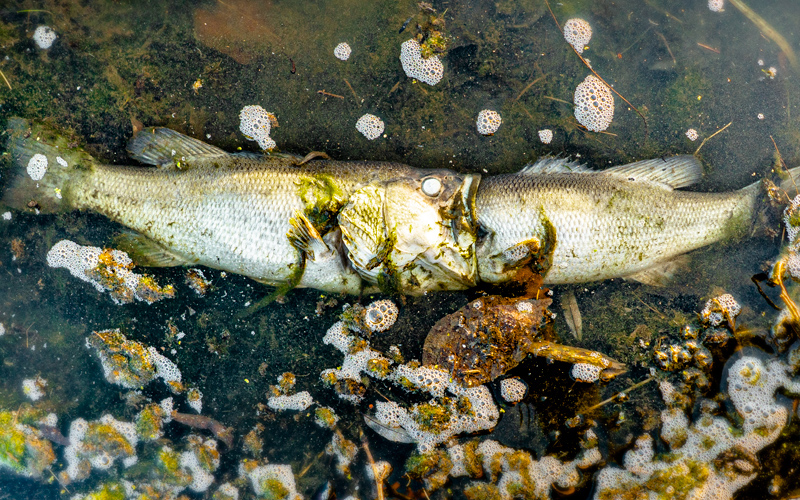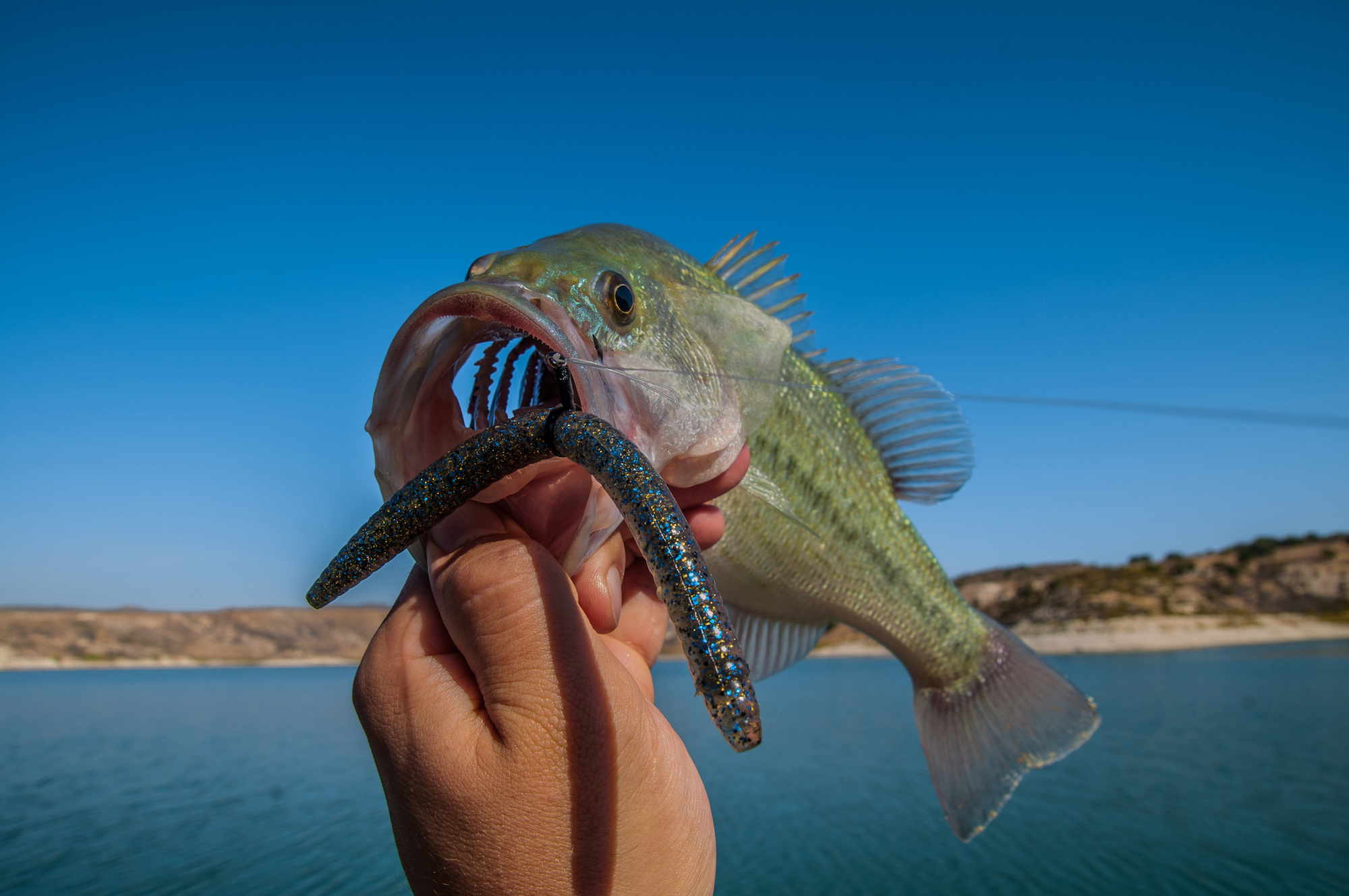Take one look at a 5-pound largemouth bass and you can tell right away these fish were built for eating. Sure, you could say the same about other freshwater species. But can you fit a grown man’s fist inside the mouth of a 5-pound trout or catfish? I didn’t think so (and please don’t try it). This physiological fact alone says a lot about the eating habits of bass. And while the jaws of a smallmouth don’t stretch quite as wide as a largemouth’s, both types of bass eat similar prey in similar ways. So, what do bass eat?
It’s a question that’s as valid in 2023 as it was in 1741, when naturalist William Bartram wrote about Seminole Indians catching Florida largemouth using crude deer-hair flies that were “nearly as large as one’s fist.” It continues to fuel anglers’ imaginations and fill tackle store shelves with an overwhelming supply of bass lures.
Read Next: The Best Soft Plastic Baits for Bass of 2023
The long-winded and scientific answer to this age-old question will be explained in the sections below. But the short answer is: A bass will eat whatever can fit in its mouth—and then some.
What Do Bass Like to Eat?
Whether we’re talking about bucketmouths on Toledo Bend Reservoir or bronzebacks on Lake Michigan, the most common bass forage includes:
- Baitfish, perch, and other smaller fish
- Crayfish
- Amphibians and reptiles
- Insects and invertebrates
This knowledge comes from both scientific research and decades of fishing for bass around the country. Todd Driscoll has been a district fisheries biologist for the Texas Parks and Wildlife Department for roughly 25 years. He’s a bass expert from East Texas, which is home to some of the most productive largemouth lakes in the country. He’s also fished in bass tournaments throughout his career, and these two perspectives have shaped his overall understanding of what bass eat.
“I would classify largemouth bass as opportunistic feeders and extremely adaptable predators,” Driscoll says. “And to a large degree, at least in Southern reservoirs, it’s understood pretty well what bass eat.”
The same generalist description holds true for smallmouth bass, which are found in waters throughout North America.
“I tournament fish all summer long, so it’s always been important to me to understand what they’re eating,” says Jeff Elliot, a federal fisheries biologist with NOAA. “We have a lot of unique [food sources] in the Great Lakes, especially when it comes to smallmouth forage.”
While smallmouth and largemouth bass do eat a lot of the same species, there are certain critters each fish prefers.
What Do Largemouth Bass Eat?
- Shad, bluegills, other bass
- Frogs
- The occasional duckling
What Do Smallmouth Bass Eat?
- Shad and other baitfish, including minnows and gobies
- Crayfish
- Mice
Baitfish and Other Bite-Sized Fish Species
Big fish eat little fish, and bass are no different. This means that baitfish are far and away the most important food source for both largemouth and smallmouth bass. The different types and species of baitfish will vary depending on the water body and location. But if we’re talking about the large reservoirs and lakes in the South, Driscoll says it’s all about shad.
“In our area, the primary forage species in terms of biomass is shad-based,” he says, adding that threadfin shad and gizzard shad are the two most common species found in East Texas lakes.

Threadfin shad are smaller and more abundant. A typical adult threadfin is around 4 to 5 inches long. Gizzard shad are huge by comparison, measuring between eight to 14 inches as adults. They get even bigger than that, though, and Driscoll has personally seen gizzard shad up to 18 inches long. At that point, he says, “they can outgrow predation,” meaning they’re too big for most bass to eat. Studies show that bass will eat prey that is as much as 60 percent of their own body size. Bass have been documented trying to take down bigger meals, and dying in the process.
After shad, the next most important forage fish is perch and other small sunfish. Bluegills top this list in many water bodies, but bass will also eat redears, pumpkinseeds, green sunfish, and every other subspecies they can get their jaws around.
Of course, largemouth and smallmouth bass are also members of the sunfish family. And since we’ve already established that bass will eat every sunfish species under the sun, bass will also eat each other.
“Cannibalism does happen a lot, and it’s usually more focused on year-old, six- to 10-inch fish predating upon the fingerlings after they hatch,” Driscoll says. “Male largemouth bass will protect hatched fry for a while, but once those fry scatter on their own, they’re fair game. A largemouth bass won’t discriminate if they find a one- to four-inch bass.”

Moving north to the Great Lakes, Elliot says shad are one of the most important food sources for smallmouth. He also adds gobies and alewives to the list of regional baitfish that smallies like to eat.
“Alewives get pretty big, up to six or seven inches, as adults,” Elliot says. “They’re an invasive, pelagic species here in the Great Lakes … but a really unique thing happens when they come into all these lakes we have on the westside to spawn in June. If you aren’t dialed into that, you’re in big trouble because the bass really key in on them.”
Crayfish
The second-most important food category for bass, according to both Driscoll and Elliot, is crayfish. These armored crustaceans can be found in most lakes and rivers where bass live, and they make up a large portion of a bass’ diet.
Growing up fishing rivers in Central Texas, I’ve caught more bass than I can count (both smallmouth and largemouth) that had little orange claws sticking out of their gullets. Fishing a crawfish pattern slow and deep might not be that exciting, but it’s incredibly effective. This is especially true in the springtime when crawdads are emerging from their winter burrows underground.
Amphibians and Reptiles
Bass love to eat frogs, and these juicy little amphibians are synonymous with warm-water bass fisheries. Bass also prey upon lizards and snakes. While not as common as swimming frogs on most water bodies, lizards do hang out near the water’s edge at times.
Throwing a topwater frog is probably the most fun way to catch largemouth bass. Watching a bass blow up on a frog bait will turn a grown adult into a grinning kid every time. Lure companies also make a variety of topwater snake baits, lizards, and other creature baits that will bring a hungry bass to the surface under the right conditions.
Insects and Invertebrates
A bass will almost always choose a big meal over a small one. In scientific terms, this all comes down to “caloric expenditure,” or the amount of energy it takes for a fish to chase down and grab its prey.
“If you follow bass fishing around the country, a trend that’s growing is fishing bigger swimbaits and glide baits, which imitate larger shad and other big baitfish,” Driscoll explains. “Once a bass gets to be five or so pounds, it will try to balance its caloric expenditure with what it gains when it feeds. So, if available, they’re always going to select those larger prey items.”
Read Next: Watch an Angler Pull a 22-inch Snake Out of a 16-inch Bass
The key phrase here is “if available.” And there are times when bugs are the most available prey item on the water. As an example, I distinctly remember one morning years ago when I stood on a dock right at sunrise. For at least five minutes, I watched a huge smallmouth sip mayfly after mayfly off the lake’s surface during a spinner fall. By the time I returned with my fly rod, the fish was long gone, but I’ve kept a handful of dry flies in my popper box ever since.
Grasshoppers, beetles, ants, spiders, and cicadas are just as important to the fly-casting bass angler (if not more so) than aquatic insects. You might not catch the biggest fish in the river—but throw a small popper or another floating bug long enough and you will certainly catch bass.
This is also where worms and other invertebrates come into play. Finessing a soft-plastic worm near structure is one of the most effective ways to catch bass, and more big bass have been caught on plastic worms than arguably any other artificial bait. So, bass must eat worms all the time, right? Not exactly.

The truth is that earthworms and nightcrawlers are landlubbers. Worms will occasionally end up in the water, but they aren’t a primary food source for bass. The reason bass eat plastic worms is because they wriggle and move so seductively in the water that they’ll often produce a reactionary strike—or what Driscoll calls a “reflex bite.” This also ties back to the opportunistic nature of bass, and the fact that they’ll eat almost anything they can swallow.
“A buzzbait is a good lure to cover a lot of water and hunt for bass, but what on earth does that mimic naturally? Nothing I can think of really,” Driscoll says. “Anglers can take advantage of their aggressive nature to get that reflex bite out of a bass. Think about a plastic worm. How often does a bass naturally come across a large worm? Or a lizard? Almost never, I would say.”
Ducklings, Mice, and Other Critters
There’s no question that a bass will eat a duckling whole. This is something that every old-school bass angler knows, and there is ample evidence of this on YouTube and other corners of the internet. There are also plenty of topwater duck lures out there for those who’d rather witness it in person.
The rat lure is another example of an over-sized artificial bait that will catch big bass, and Elliot has seen plenty of mice-eaters in his years chasing smallies in the Midwest.
“I’ve definitely caught several bass with mouse tails sticking out of their throats,” he says. “Call it weird, but if you ever walk along the banks, you’ll sometimes see a little mouse or vole jump right into the lake and scurry across—and I imagine that’s how they get eaten. If it’s small and brown and it moves, I don’t think a bass can say no.”
As for other larger-than-average prey items, we’ll never know for certain the biggest thing a bass has ever eaten. Still, there are plenty of anecdotes out there, and I’ve even heard of largemouth bass eating baby alligators.
“There’s credence to all of it. Ducklings might not be frequent [prey] but that absolutely happens,” Driscoll says. “There’s also no reason why a seven- to eight-pound bass wouldn’t try to eat a baby alligator. When they’re ready to eat, they’re gonna eat whatever presents itself and is small enough that they can digest. It’s really just that simple.”
What Do Striped Bass Eat?
Striped bass living in saltwater are a whole ‘nother animal as the ocean provides an even more diverse buffet of prey items. Still, their diet mostly revolves around saltwater baitfish such as menhaden, bunker, and herring. Striped bass will also eat:
- Eels
- Squid
- Bloodworms and sandworms
- Mussels, crabs, and other small shellfish
What Do Rock Bass Eat?
Rock bass are a lot like mini smallmouths. They eat many of the same foods as smallmouth bass, including:
- Crayfish
- Smaller baitfish
- Aquatic insects
What Do White Bass Eat?
White bass have more in common with striped bass than other subspecies of bass. As they grow, they transition from eating microscopic animals to chasing schools of baitfish. Their favorite foods include
- Zooplankton
- Insect larvae
- Small shad and minnows
